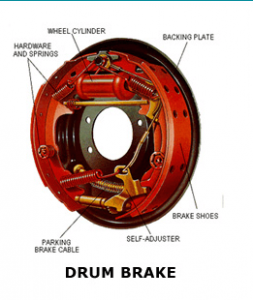Brake Repair
The use for brakes naturally arose when humans began traveling using transportation techniques other than their legs. Whether it is by land, air or sea, the need for brakes mitigates the risk of accidents which cause injuries and even death. With the popular rise of the automobile in the United States, accidents became a daily occurrence. However, two things occurred which increased fatalities: 1.) High-speed highways became the norm, and 2.) Vehicles became cheaper but more powerful.
Since fatalities from car accidents were on the rise, society realized that safety standards need to be developed and enforced to protect consumers. So, by 1970, the National Highway Traffic Administration was formed to combat the rise in fatalities and instill a culture of “safety first” in automobile design.
Recently, the NHTA is now adding
the need for an Automatic Emergency Braking feature to qualify for a 5-star rating. So, having a well-designed braking system is a big part of an overall process of avoiding injury from car accidents. But how do car brakes work?
How Brakes Work
Understanding how brakes work will help you look out or any irregularities in your braking system, therefore increasing safety on the road for everyone. The braking systems of today use multiple sensors and electronics to stop a car as quickly as possible. Nonetheless, the primary braking system is still used.
When you press the braking pedal, that pressure moves a piston in the master cylinder, forcing braking fluid to enter the brake lines to the calipers and wheel cylinders. The force applied to the brake pedal is therefore proportional to the force applied to the pistons.
The calipers in disk brakes and wheel cylinders in drum brakes are connected to disk pads and braking shoes respectively. The pistons push the disk pads or braking shoes onto the rotor or wall, causing friction and resulting in the decreased rotation of the wheel.
Components of the Braking System

Braking systems include either disk brakes or drum brakes. Disk Brakes are comprised of a disc/rotor, calipers, disk pads and hardware necessary to mount the components to the car. The caliper is connected to the hoses and wires that send the braking fluid when the brake pedal is depressed.
Drum brakes are comprised of a drum/braking plate, brake shoes, a wheel cylinder, and hardware to mount the components. The wheel cylinder is connected to the hoses and wires send the braking fluid when the brake pedal is depressed.
Braking Fluid
Water used to be used as a braking fluid in the past. However, the braking process causes temperatures to rise past the boiling point of water. This causes water to vapor resulting in brake failure.
Braking fluid is a hydraulic fluid with a high boiling point. Hydraulic fluids are used to transfer power, in this case, from the pedal to the calipers and cylinders while surviving high temperatures caused by braking. Braking fluid also protects against corrosion of systems it comes in contact with.
When to Schedule your Car for Brake Services
This is what to look for to bring your car in for brake services:
- Noise or grinding coming from the brakes
- Brake pedal feels spongy or soft when pressed
- Car veers a certain way when the brakes are pressed
- Brake fluid level in the master cylinder is low
- Brake system Warning Lamp is on
Did we miss anything? Leave a comment and let us know.
Brake Services by European Service Center
Alpharetta Motor Sports has 35 years of experience in maintaining vehicles. Our ASE certified service mechanics are highly trained and have the tools to inspect, diagnose, and repair any braking issue you may be having.
Schedule your appointment today.




